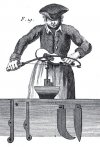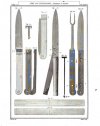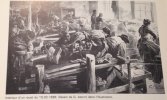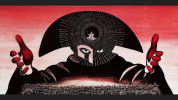-
The BladeForums.com 2024 Traditional Knife is available! Price is $250 ea (shipped within CONUS).
Order here: https://www.bladeforums.com/help/2024-traditional/
You are using an out of date browser. It may not display this or other websites correctly.
You should upgrade or use an alternative browser.
You should upgrade or use an alternative browser.
"Carl's Lounge" (Off-Topic Discussion, Traditional Knife "Tales & Vignettes")
- Thread starter jackknife
- Start date
- Joined
- Oct 29, 2016
- Messages
- 1,217
I've sometimes wondered why exchange posts seem overly detailed... now I know. I also think there's a tendency to rush to the sale items and not read the terms carefully. Esp. with highly sought after names. And then there's them who are a little short on common sense....Folks, please advise, if I post something in The Exchange, For Sale, do I really have to post NO TRADES in order to avoid unsolicited PM's!? Also, NO WILD OFFERS?
- Joined
- Jun 4, 2015
- Messages
- 6,140
???LOL! Probably too much red wine!

You got it dead center Rachel, usually it is followed by ... jusque là... (until now) the best example being expressed by a guy falling from the 15th floorThat is strange, but don't worry. Everything is fine.
One can also cross fingers.
Certainly a good choice if you suffer of insomnia or appreciate unexpected third degree humour. Godard (a Swiss citizen) then shouted everywhere he was MaoïstTout Va Bien was the title of a 1972 French film directed by Jean-Luc Godard (whom I confuse with Captain Jean-Luc Picard) and starring Jane Fonda.
Miss Fonda always had a lot of followers in France and I was certainly interested by her... acting in Barbarella...

- Joined
- Jun 4, 2015
- Messages
- 6,140
The complete name is Montagne thiernoise, Thiers is THE big city of cutlery, were most big firms are. But a lot of work is contracted outside in the surrounding mountain in smaller villages, la Monnerie, Viscomtat, Chabreloche, etc. (all sold as coming from Thiers) where conditions of living are much tougher than in the city and distances are in time rather than km.Jolipapa, that's a great way to get folks, and esp. young folk, interesting in cutlery! I think, no, I know, I would very much have appreciated that opportunity as a boy.
Question about your last pic, what is meant by 'in the mountain'?

On the pictures (not mine, more here : http://couteauxdepoche.forumchti.com/t5334-destination-paris) the name of the village is in italic, on the left the name of the maker :



- Joined
- Dec 2, 2005
- Messages
- 71,102
Tout va bien!
I have felt "all's well" when I put an SFO to bed, so to speak!
But I am a long way from dreaming it in French!!
Maybe in Italian - it's close; "va tutto bene".
You did a great job, Jack!! It can be a trial!!
Thanks for everything Charlie

Good response, r8shell, and what I planned to say once Google told non-French-speaking me what Jack's phrase meant!
(Actually, I'd probably have gone with a current catchphrase of my students: It's all good.
)
But Google also revealed to me that Tout Va Bien was the title of a 1972 French film directed by Jean-Luc Godard (whom I confuse with Captain Jean-Luc Picard) and starring Jane Fonda. I've not seen this movie, but I remember Jane Fonda ca. 1972
, and she could certainly make a lasting impression on an adolescent Jack Black if he happened to see the film!!

You're right about Jane Fonda leaving a lasting impression my friend, but not in Tout Va Bien, which I don't recall ever having seen!

The complete name is Montagne thiernoise, Thiers is THE big city of cutlery, were most big firms are. But a lot of work is contracted outside in the surrounding mountain in smaller villages, la Monnerie, Viscomtat, Chabreloche, etc. (all sold as coming from Thiers) where conditions of living are much tougher than in the city and distances are in time rather than km.

On the pictures (not mine, more here : http://couteauxdepoche.forumchti.com/t5334-destination-paris) the name of the village is in italic, on the left the name of the maker :



Excellent post JP

- Joined
- Dec 2, 2005
- Messages
- 71,102
Thank you. The cutlery and other industries were called mill's valley, vallée des usines, along the Durolle river.

Thanks JP, I remember that name, and the pic, from when you were helping me research one of the few French knives I've picked up

- Joined
- Oct 29, 2016
- Messages
- 1,217
Thank you Jolipapa. Now I may add Thiers to my list of cities to visit next time in Europe, along with Solingen and Sheffield.
You mean 'Hanoi Jane'? My father in law, being a vet, would not allow that name to be mentioned in their house. (My father, also a vet, felt the same way about John Wayne, who skipped the war because his acting career was just taking off.)
You mean 'Hanoi Jane'? My father in law, being a vet, would not allow that name to be mentioned in their house. (My father, also a vet, felt the same way about John Wayne, who skipped the war because his acting career was just taking off.)
Last edited:
- Joined
- May 23, 2015
- Messages
- 4,161

On the pictures (not mine, more here : http://couteauxdepoche.forumchti.com/t5334-destination-paris) the name of the village is in italic, on the left the name of the maker :
Jolipapa regardless of the source of this picture it is absolutely beautiful and is now my desktop background thank you so much for posting it my friend.


- Joined
- Jun 29, 2014
- Messages
- 1,291
For the 50th anniversary of the French national parks, my friends of the La Monnerie Old Blades (vieilles lames) are guests of the Livradois-Forez park,View attachment 779653
they exhibit some of their traditional tools View attachment 779654 View attachment 779655
and propose to assemble a Verdier friction folder à la Opinel, View attachment 779656
or, for the children, a fixed blade tartineur, as they regularly do in local village feasts. View attachment 779657
Here some knives made in the Mountain (sorry for the crappy picture). View attachment 779658
Great posts and pictures, JP.

What an excellent idea, to have visitors to the stall assemble their own knife that they can keep.

I was particularly interested to see the traditional cutlers tools. I think I have worked out the purpose of most of them (bow drill with breast-plate, burnishers, tool for milling/coining liners etc) but I am still puzzled by the tools second from left in both photos. Any idea what they are used for?
Here's a very early illustration (possibly the earliest) of a cutler using a bow drill, from Jean-Jacque Perret's 1771 work, L'art du Coutelier.

- Joined
- Dec 2, 2005
- Messages
- 71,102
Thanks for sharing that fantastic illustration Chin  Doesn't that cutler look pleased with himself?!
Doesn't that cutler look pleased with himself?! 

 Doesn't that cutler look pleased with himself?!
Doesn't that cutler look pleased with himself?! - Joined
- Jun 29, 2014
- Messages
- 1,291
- Joined
- Dec 2, 2005
- Messages
- 71,102
LOL, he does mate! But then, with arcane, cool looking kit like that, wouldn't you be?!
View attachment 781689
Wonder if it was old Jacques, himself in the engraving?
Brings a new meaning to the term Little maestro!!
Yes indeed!
I wondered that too

- Joined
- Jun 4, 2015
- Messages
- 6,140
Randy, this is a winter 2005-6 picture I found here : https://fr.wikipedia.org/wiki/ViscomtatJolipapa regardless of the source of this picture it is absolutely beautiful and is now my desktop background thank you so much for posting it my friend.
If you check Viscomtat's mayors names, you'll find many cutlery related names (Chevalerias, Chambriard, Gonon, Dubost, Dumas...)
They have recently intalled a living museum in La Monnerie, with bigger machines they found somtime in junkyards and have tons of knife parts to assemble the old way. (none my picture)Great posts and pictures, JP.
What an excellent idea, to have visitors to the stall assemble their own knife that they can keep.
I was particularly interested to see the traditional cutlers tools. I think I have worked out the purpose of most of them (bow drill with breast-plate, burnishers, tool for milling/coining liners etc) but I am still puzzled by the tools second from left in both photos. Any idea what they are used for?
Here's a very early illustration (possibly the earliest) of a cutler using a bow drill, from Jean-Jacque Perret's 1771 work, L'art du Coutelier.
View attachment 781671




They also organize a show in La Monnerie and attend to local events in surrounding villages.
(more here )

No idea for the purpose of these tools, I'll ask.
Judging by the garments he wears, the happy cutler must have been in healthy Paris, Châtellerault or Langres, surely not Thiers.
- Joined
- Jun 29, 2014
- Messages
- 1,291
Randy, this is a winter 2005-6 picture I found here : https://fr.wikipedia.org/wiki/Viscomtat
If you check Viscomtat's mayors names, you'll find many cutlery related names (Chevalerias, Chambriard, Gonon, Dubost, Dumas...)
They have recently intalled a living museum in La Monnerie, with bigger machines they found somtime in junkyards and have tons of knife parts to assemble the old way. (none my picture)




They also organize a show in La Monnerie and attend to local events in surrounding villages.
(more here )

No idea for the purpose of these tools, I'll ask.
Judging by the garments he wears, the happy cutler must have been in healthy Paris, Châtellerault or Langres, surely not Thiers.
Thanks JP.
That museum looks like it would be a fascinating place to visit.
You're right about master cutler, Jean-Jacque Perret not being from Thiers. I understand he was born in Beziers in 1730 and had his works in Paris. I'm impressed you could tell that from his clothing!
L'art du Coutelier is a book that would be extremely illuminating in understanding the origins and earliest development of the spring back pocket knife. Although, Bernard Levine has translated some parts of it into English, sadly, I do not think all three volumes have ever been translated - at least, not in a form that is publically available.
Nonetheless, the pictures alone make a fascinating read for the student of cutlery history.
I sometimes wonder whether Jean-Jacque Perret's innovations in cutlery design may have been what was being referred to by English cutlers when they spoke of the 'jack-knife', although that is just idle speculation on my part. He was also an innovator of the safety razor (he invented a kind of wooden sheath for a straight razor, inspired by the plane), and various surgical tools.

Last edited:
- Joined
- Jun 4, 2015
- Messages
- 6,140
Thank you for the link, some years ago (15?, 20?) there has been a reedition of Perrets' book but then I had a lesser interest in knives and it was very luxurious and expensive.
He is well known by the cutlers and knife lovers but I could not find a single word about him (he is unknown) even in the big 10+ volumes Larrousse encyclopedia... What a shame!
In the forewords he explains that he decided to write the book because as a surgeon he knew how to use surgery tools, but was unable to explain to a country smith how make them!
Amazing to see that except for a few changes (the letter "s" did not exist and was printed as a "f", most "ai" was "oi", etc) it is quite easy to read and the language clearly made to be understood by anybody.
He is well known by the cutlers and knife lovers but I could not find a single word about him (he is unknown) even in the big 10+ volumes Larrousse encyclopedia... What a shame!
In the forewords he explains that he decided to write the book because as a surgeon he knew how to use surgery tools, but was unable to explain to a country smith how make them!
Amazing to see that except for a few changes (the letter "s" did not exist and was printed as a "f", most "ai" was "oi", etc) it is quite easy to read and the language clearly made to be understood by anybody.
- Joined
- Dec 2, 2005
- Messages
- 71,102
Fascinating discussion gents 

- Joined
- Dec 2, 2005
- Messages
- 71,102
Chui-888 drew my attention to this document yesterday - Proposals for changes in the UK knife laws - https://www.gov.uk/government/uploa...nsive_and_Dangerous_Weapons-Consultation-.pdf
Not the place for political commentary, but I'm posting this for the information of our other UK members, and those visiting the UK - Your Svord Peasant could be set to be reclassified as an illegal 'flick knife', you may no longer be able to purchase knives online, and knives in your private collection are in danger of being seized. Read it and weep!
Not the place for political commentary, but I'm posting this for the information of our other UK members, and those visiting the UK - Your Svord Peasant could be set to be reclassified as an illegal 'flick knife', you may no longer be able to purchase knives online, and knives in your private collection are in danger of being seized. Read it and weep!
- Joined
- Jun 29, 2014
- Messages
- 1,291
Thanks JP, that's very interesting.
Yes, I think the first two volumes detail the making of surgical instruments, and the third one is concerned with cutlery.
What a pity Perret has no entry in the Larrousse encyclopedia: he certainly seems like one of the great geniuses of edged tool design and cutlery development.
On a slightly different note, I think I may have posted this pic before, of 19th century French cutlers with their dogs keeping their legs warm, but I like it so much I'm posting it again.

Interesting that there appear to be women cutlers at work too.
(One of the Sheffield women migrants quoted in the GEC book, recalled how there were quite a few women cutlers back in her day, in the 'old country' IIRC).
Yes, I think the first two volumes detail the making of surgical instruments, and the third one is concerned with cutlery.
What a pity Perret has no entry in the Larrousse encyclopedia: he certainly seems like one of the great geniuses of edged tool design and cutlery development.
On a slightly different note, I think I may have posted this pic before, of 19th century French cutlers with their dogs keeping their legs warm, but I like it so much I'm posting it again.

Interesting that there appear to be women cutlers at work too.
(One of the Sheffield women migrants quoted in the GEC book, recalled how there were quite a few women cutlers back in her day, in the 'old country' IIRC).
- Joined
- May 9, 2010
- Messages
- 10,339
Thanks JP.
That museum looks like it would be a fascinating place to visit.
You're right about master cutler, Jean-Jacque Perret not being from Thiers. I understand he was born in Beziers in 1730 and had his works in Paris. I'm impressed you could tell that from his clothing!
L'art du Coutelier is a book that would be extremely illuminating in understanding the origins and earliest development of the spring back pocket knife. Although, Bernard Levine has translated some parts of it into English, sadly, I do not think all three volumes have ever been translated - at least, not in a form that is publically available.
Nonetheless, the pictures alone make a fascinating read for the student of cutlery history.
I sometimes wonder whether Jean-Jacque Perret's innovations in cutlery design may have been what was being referred to by English cutlers when they spoke of the 'jack-knife', although that is just idle speculation on my part. He was also an innovator of the safety razor (he invented a kind of wooden sheath for a straight razor, inspired by the plane), and various surgical tools.
View attachment 781716
cool! i wonder if thats the inspiration for the case hobo models!

